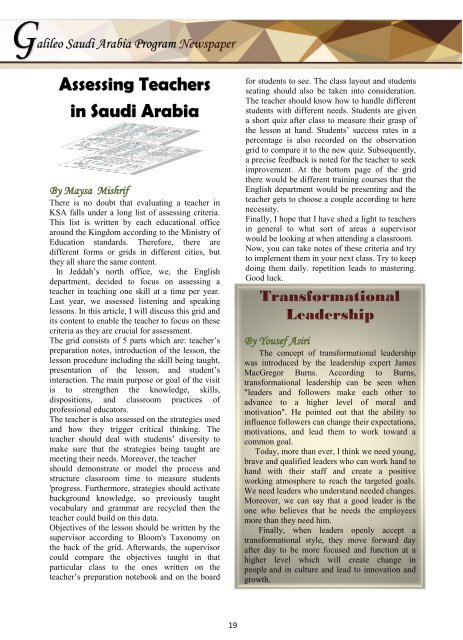Newspaper Khebrat Wave2 Oakland 2018
You also want an ePaper? Increase the reach of your titles
YUMPU automatically turns print PDFs into web optimized ePapers that Google loves.
Galileo Saudi Arabia Program <strong>Newspaper</strong><br />
Assessing Teachers<br />
in Saudi Arabia<br />
By Maysa Mishrif<br />
There is no doubt that evaluating a teacher in<br />
KSA falls under a long list of assessing criteria.<br />
This list is written by each educational office<br />
around the Kingdom according to the Ministry of<br />
Education standards. Therefore, there are<br />
different forms or grids in different cities, but<br />
they all share the same content.<br />
In Jeddah’s north office, we, the English<br />
department, decided to focus on assessing a<br />
teacher in teaching one skill at a time per year.<br />
Last year, we assessed listening and speaking<br />
lessons. In this article, I will discuss this grid and<br />
its content to enable the teacher to focus on these<br />
criteria as they are crucial for assessment.<br />
The grid consists of 5 parts which are: teacher’s<br />
preparation notes, introduction of the lesson, the<br />
lesson procedure including the skill being taught,<br />
presentation of the lesson, and student’s<br />
interaction. The main purpose or goal of the visit<br />
is to strengthen the knowledge, skills,<br />
dispositions, and classroom practices of<br />
professional educators.<br />
The teacher is also assessed on the strategies used<br />
and how they trigger critical thinking. The<br />
teacher should deal with students’ diversity to<br />
make sure that the strategies being taught are<br />
meeting their needs. Moreover, the teacher<br />
should demonstrate or model the process and<br />
structure classroom time to measure students<br />
'progress. Furthermore, strategies should activate<br />
background knowledge, so previously taught<br />
vocabulary and grammar are recycled then the<br />
teacher could build on this data.<br />
Objectives of the lesson should be written by the<br />
supervisor according to Bloom's Taxonomy on<br />
the back of the grid. Afterwards, the supervisor<br />
could compare the objectives taught in that<br />
particular class to the ones written on the<br />
teacher’s preparation notebook and on the board<br />
for students to see. The class layout and students<br />
seating should also be taken into consideration.<br />
The teacher should know how to handle different<br />
students with different needs. Students are given<br />
a short quiz after class to measure their grasp of<br />
the lesson at hand. Students’ success rates in a<br />
percentage is also recorded on the observation<br />
grid to compare it to the new quiz. Subsequently,<br />
a precise feedback is noted for the teacher to seek<br />
improvement. At the bottom page of the grid<br />
there would be different training courses that the<br />
English department would be presenting and the<br />
teacher gets to choose a couple according to here<br />
necessity.<br />
Finally, I hope that I have shed a light to teachers<br />
in general to what sort of areas a supervisor<br />
would be looking at when attending a classroom.<br />
Now, you can take notes of these criteria and try<br />
to implement them in your next class. Try to keep<br />
doing them daily. repetition leads to mastering.<br />
Good luck.<br />
By Yousef Asiri<br />
The concept of transformational leadership<br />
was introduced by the leadership expert James<br />
MacGregor Burns. According to Burns,<br />
transformational leadership can be seen when<br />
"leaders and followers make each other to<br />
advance to a higher level of moral and<br />
motivation". He pointed out that the ability to<br />
influence followers can change their expectations,<br />
motivations, and lead them to work toward a<br />
common goal.<br />
Today, more than ever, I think we need young,<br />
brave and qualified leaders who can work hand to<br />
hand with their staff and create a positive<br />
working atmosphere to reach the targeted goals.<br />
We need leaders who understand needed changes.<br />
Moreover, we can say that a good leader is the<br />
one who believes that he needs the employees<br />
more than they need him.<br />
Finally, when leaders openly accept a<br />
transformational style, they move forward day<br />
after day to be more focused and function at a<br />
higher level which will create change in<br />
people and in culture and lead to innovation and<br />
growth.<br />
19


